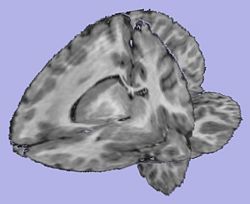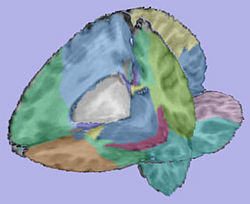DBP2:UNC:Local Cortical Thickness Pipeline
From NAMIC Wiki
Home < DBP2:UNC:Local Cortical Thickness Pipeline
Back to UNC Cortical Thickness Roadmap
Contents
Objective
We would like to create an end-to-end application within Slicer3 allowing individual and group analysis of local cortical thickness.
Pipeline overview
Input: RAW images (T1-weighted, T2-weighted, PD-weighted images)
- 1. Tissue segmentation
- Probabilistic atlas-based automatic tissue segmentation via an Expectation-Maximization scheme
- Tool: itkEMS (UNC Slicer3 external module)
- 2. Atlas-based ROI segmentation: subcortical structures, lateral ventricles, parcellation
- 2.1 T1-weighted atlas deformable registration
- B-spline pipeline registration
- Tool: RegisterImages (Slicer3 module)
- 2.2. Applying transformations to the structures
- Tool: ResampleVolume2 (Slicer3 module)
- 2.1 T1-weighted atlas deformable registration
- 3. White matter map creation
- Brainstem and cerebellum extraction
- Adding subcortical structures except amygdala and hippocampus
- Tool: ImageMath (NITRC module)
- 4. White matter map post-processing
- Largest component computation
- Smoothing: Level set smoothing or weighted average filter
- Connectivity enforcement (6-connectivity)
- White matter filling
- Tool: WMSegPostProcess (UNC Slicer3 external module)
- 5. Genus zero white matter map image and surface creation
- Tool: GenusZeroImageFilter (UNC Slicer3 external module)
- 6. White matter surface inflation
- Iterative smoothing using relaxation operator (considering average vertex) and L2 norm of the mean curvature as a stopping criterion
- Iteration stopped if vertices that have too high curvature (some extremities)
- Tool: MeshInflation (UNC Slicer3 external module)
- 6 bis(Optional). White matter image fixing if necessary
- Correction of the white matter map image (corresponding to vertices that have high curvature) with connectivity enforcement
- Tool: FixImage (UNC Slicer3 external module)
- Go back to step 5
- 7. Gray matter map creation
- Adding genus zero white matter map to gray matter segmentation (without cerebellum and brainstem)
- Tool: ImageMath
- 8. Label map creation
- Label map creation for cortical thickness computation (WM + GM + CSF)
- Tool: ImageMath
- 9. Cortical thickness
- Asymmetric local cortical thickness or Laplacian cortical thickness
- Tool: UNCCortThick or measureThicknessFilter (UNC Slicer3 external modules)
- 10. Sulcal depth
- Sulcal depth computation using genus zero surface and inflated one
- Tool: MeshMath (UNC module)
- 11. Cortical correspondence
- Correspondence on inflated surfaces using particle system
- Tools: ParticleCorrespondencePreProcessing, ParticleCorrespondence, ParticleCorrespondencePostProcessing (UNC Slicer3 external modules)
- 12. Group statistical analysis
- Tool: QDEC Slicer module or StatNonParamPDM
- 1. Tissue segmentation
Download
Pipeline validation
Analysis on a small pediatric dataset
Tests will be computed on a small pediatric dataset which includes 2 year-old and 4 year-old cases.
- 16 autistic cases
- 1 developmental delay
- 3 normal control
Comparison to state of the art
We would like to compare our pipeline with FreeSurfer. We will thus perform a regional statistical analysis using Pearson's correlation coefficient on an adult dataset (FreeSurfer's publicly available tutorial dataset) including 40 cases.
Planning
Done
Steps 1 to 10
In progress
- Step 6: Parameter adjustment on autism dataset to fix bad vertices
- Step 11: Particle correspondence testing with pediatric surfaces
Future work
- Full pipeline working on pediatric dataset
- Workflow for individual analysis as a Slicer3 high-level module using BatchMake
- Workflow for group analysis






